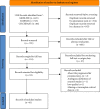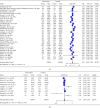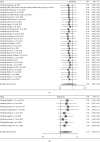Association of Statin Use with the Risk of Incident Prostate Cancer: A Meta-Analysis and Systematic Review
- PMID: 36561541
- PMCID: PMC9767737
- DOI: 10.1155/2022/7827821
Association of Statin Use with the Risk of Incident Prostate Cancer: A Meta-Analysis and Systematic Review
Abstract
Background: With the growth and aging of population, the incidence of prostate cancer will increase year by year, which is bound to bring greater economic burden to the society. There has been greater interest in the anticancer effects of statin in recent years. It is controversial whether statin use is associated with the risk of prostate cancer (PCa). Thus, we conducted a meta-analysis and systematic review to explore the effects of statin use and their duration and cumulative dose on the overall incidence of PCa.
Method: The study was conducted according to the latest guidelines for PRISMA 2020. We searched PubMed and other databases for studies about the association of statin use with the risk of incident prostate cancer between January 1, 1990, and April 11, 2022. Two independent researchers extracted data and evaluated the quality of the studies. R x64 4.1.2 and random-effects model were used for data statistics. Relative risk (RR) and odds ratio (OR) effective values with a 95% confidence interval (95% CI) were used to assess the main results.
Results: The results of 6 RCT and 26 cohort studies showed that statins did not significantly associate with the incidence of PCa (RR = 0.94, 95% CI: 0.82-1.08). The similar results were obtained from 9 case-control studies (OR = 1.03, 95% CI: 0.99-1.07). However, statins were associated with a lower risk of Pca (RR = 0.44, 95% CI: 0.28-0.70) when the cumulative defined daily dose (cDDD) was high. Using statins for more than five years could be associated with a reduced incidence of Pca (RR = 0.47, 95% CI: 0.23-0.97). There was a significant heterogeneity in these studies (RCT and cohort study: I 2 = 98%, P < 0.01; case-control study: I 2 = 72%, P < 0.01).
Conclusion: We concluded that statins had a neutral association with the overall risk of PCa. High cDDD and long duration were associated with a lower risk of PCa.
Copyright © 2022 Meng-Yao Xu et al.
Conflict of interest statement
The authors declare that they have no conflicts of interest.
Figures






Similar articles
-
Statin use and risk of prostate cancer: a meta-analysis of observational studies.PLoS One. 2012;7(10):e46691. doi: 10.1371/journal.pone.0046691. Epub 2012 Oct 1. PLoS One. 2012. PMID: 23049713 Free PMC article.
-
Statin Use and the Risk of Prostate Cancer Biochemical Recurrence Following Definitive Therapy: A Systematic Review and Meta-Analysis of Cohort Studies.Front Oncol. 2022 May 9;12:887854. doi: 10.3389/fonc.2022.887854. eCollection 2022. Front Oncol. 2022. PMID: 35615153 Free PMC article.
-
The Suggested Unique Association Between the Various Statin Subgroups and Prostate Cancer.Eur Urol Focus. 2021 May;7(3):537-545. doi: 10.1016/j.euf.2020.06.005. Epub 2020 Jun 30. Eur Urol Focus. 2021. PMID: 32620539
-
Statin Use Is Associated with Better Prognosis of Patients with Prostate Cancer after Definite Therapies: A Systematic Review and Meta-Analysis of Cohort Studies.J Oncol. 2022 Nov 15;2022:9275466. doi: 10.1155/2022/9275466. eCollection 2022. J Oncol. 2022. PMID: 36425939 Free PMC article. Review.
-
The Effects of Statins on Prostate Cancer Patients Receiving Androgen Deprivation Therapy or Definitive Therapy: A Systematic Review and Meta-Analysis.Pharmaceuticals (Basel). 2022 Jan 22;15(2):131. doi: 10.3390/ph15020131. Pharmaceuticals (Basel). 2022. PMID: 35215243 Free PMC article. Review.
Cited by
-
Opposing impact of hypertension/diabetes following hormone therapy initiation and preexisting statins on castration resistant progression of nonmetastatic prostate cancer: a multicenter study.Sci Rep. 2024 Oct 4;14(1):23119. doi: 10.1038/s41598-024-73197-y. Sci Rep. 2024. PMID: 39367145 Free PMC article.
-
Association between genetically proxied HMGCR inhibition and male reproductive health: A Mendelian randomization study.Medicine (Baltimore). 2023 Sep 29;102(39):e34690. doi: 10.1097/MD.0000000000034690. Medicine (Baltimore). 2023. PMID: 37773823 Free PMC article.
-
Evaluating the Impact of Common Non-Oncologic Medication Use During Radiotherapy in Patients with High-Risk Prostate Cancer.Curr Oncol. 2025 Jun 15;32(6):353. doi: 10.3390/curroncol32060353. Curr Oncol. 2025. PMID: 40558296 Free PMC article.
-
2022 Update on Prostate Cancer Epidemiology and Risk Factors-A Systematic Review.Eur Urol. 2023 Aug;84(2):191-206. doi: 10.1016/j.eururo.2023.04.021. Epub 2023 May 16. Eur Urol. 2023. PMID: 37202314 Free PMC article.
-
Pharmacological Efficacy of Repurposing Drugs in the Treatment of Prostate Cancer.Int J Mol Sci. 2023 Feb 19;24(4):4154. doi: 10.3390/ijms24044154. Int J Mol Sci. 2023. PMID: 36835564 Free PMC article. Review.
References
LinkOut - more resources
Full Text Sources
Miscellaneous

